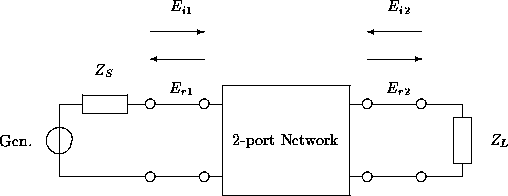Let's insert a two-port network into the transmission line as shown in Figure 7.
Looking at ![]() , we see that it is made up of that portion of
, we see that it is made up of that portion of ![]() reflected from the output port as well as that portion of
reflected from the output port as well as that portion of ![]() that is
transmitted through the network.
that is
transmitted through the network.

Figure 7: 2-port network inserted in to a transmission line
It should be possible to relate these four traveling wave by a set of parameters. For example,

By substituting the expression for a total voltage and total current
on a transmission line into this parameter set, we can rearrange these
equations such that the incident traveling voltage waves are the independent
variables; and the reflected traveling waves are the dependent variables
![]()
The functions ![]() and
and ![]() represent a new set of
network parameters relating traveling voltage waves rather than total voltages
and total currents. In this case, these functions are expressed in terms of
y-parameters. They could have been derived from any other parameter set. We call
this new parameter set "scattering parameter" or S-parameter. We can divide
both sides of the above equations by
represent a new set of
network parameters relating traveling voltage waves rather than total voltages
and total currents. In this case, these functions are expressed in terms of
y-parameters. They could have been derived from any other parameter set. We call
this new parameter set "scattering parameter" or S-parameter. We can divide
both sides of the above equations by ![]() , the characteristic impedance
of the transmission line, the parameter set will not change. It will, however,
give us a set of new variables:
, the characteristic impedance
of the transmission line, the parameter set will not change. It will, however,
give us a set of new variables:

Notice that the square of the magnitude of these new variables has the dimension of
power. ![]() can then be thought of as the incident power on port one.
can then be thought of as the incident power on port one.
![]() can then be thought of as the reflected power on port one. These new
waves can be called traveling power waves rather than traveling voltage waves.
Throughout this notes, we will simply refer to these waves as traveling waves.
can then be thought of as the reflected power on port one. These new
waves can be called traveling power waves rather than traveling voltage waves.
Throughout this notes, we will simply refer to these waves as traveling waves.
Finally, we see that the S-parameter relate these four waves in this fashion
![]()